Summer Exploring: Switzerland & The Loire
By Cornelia Seckel
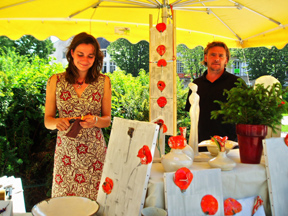 Marc & Virgnie
& Marc Drillien selling their sculpture and Jewelry at the Saturday Market in Beaune, France Marc & Virgnie
& Marc Drillien selling their sculpture and Jewelry at the Saturday Market in Beaune, France |
This was the first time in 23 years that we didn’t have an issue to prepare for publication during July. It was time for us to do some summer exploring and our friends from Europe were most helpful. Over the past years we have traveled with Jacky Sparkowsky and Jörg Iwan (the last trip was to Budapest and to Vienna in Jan ‘05) and had talked with Heinz & Christiane Jarczyk about the men painting and the women hiking in the Alps in Switzerland. Finally we were able to recognize those dreams and, of course, do some arts & culture exploring.
Jacky
& Jörg picked us up at the Geneva Airport and we headed west into France. I only knew that we were going to explore the Loire
Valley and had hardly needed to make
any arrangements other than our travel to and from Geneva. Many of the
places that we went to they had visited many years ago, and so there was
a sense of familiarity for them and a newness as they shared it with us.
Our first day and we headed towards Dijon and spent 2 nights in Beaune so we could explore the area. I love open markets and we were fortunate
to be in Beaune for the Saturday Market. Here I met up with Marc
& Virgnie Drillien selling their
sculpture, jewelry and pottery. We spoke a bit about the life of craftspeople
and they told me that they like living in their small village in the country
and traveling to different craft events and open markets to sell their
work. They also have their work at several stores. Virgnie makes the jewelry
of ceramic forms and beads and does some sculpting; Marc sculpts and makes
much of the pottery. They are members of a small crafts organization and
life for the craftsperson doesn’t seem to be so different from here in
the States. Beaune has an International Baroque Opera Festival over 5 weekends in July held at the Hospices de Beaune. In 1440 Nicolas
Rolin, Chancelor of the Duke of Bourgogne Philippe le Bon,
and his wife Giugone de Salins decided to create a pious foundation
to address the poverty and illness that followed the Hundred Year’s
War. They endowed it with an annual income from saltworks and vineyards
that still supports the Hospices de Beaune. This hospital continued to
function in this place until 1971 when the medical activities were transferred
to a modern hospital. A retirement home remained.
At this point in my narrative I must say that my relating of historical
information is coming from several sources, all of them tourist-related
and so I would ask that you forgive any errors and accept that I am just
giving a sense of the times and places in this report. Radical errors
I would appreciate knowing about so I can correct my own thinking and
this report which also goes online.
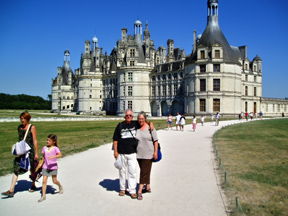 R.J. Steiner and Cornelia Seckel in front of Chateau Chambord, Val de Loire, France |
On our way to Montrichard (a small city along the Cher River)
there were fields and fields of sunflowers and wheat and then fields of
grapes and more sunflowers. We stayed 3 nights at Chateau de
la Menaudière and from this Chateau, originally owned by the king’s
tax collector with history dating from the early 1500’s, we explored the Loire Valley known for
beautiful Chateaux, fertile soil, good climate, rich culture, and history.
Each of the castles we visited offered another lesson in the history of
France and Europe. In Amboise,
which was the principal settlement of the Celtic Turones tribe (around 50 BCE), we visited Chateau d’Amboise, a privately owned Chateau belonging to a direct descendant
of France’s royal line. It was here that Italian tastes were first introduced
into the Loire Valley as Leonardo da Vinci had been invited to join the French court at Amboise
in 1516. He spent his time drawing and teaching, concentrating on architecture
and urban planning including some of the designs for Chambord. In 1519
he died and was buried (as he wished) at the Chateau. On the grounds of
the Chateau there is a model of his tank and a model of the solar system
as he knew it. The Chateau du Clos-Lucé was the manor house where Leonardo da Vinci lived, and most of the rooms
are open to visitors. Also on display are several models made from his
drawings. The next day we went to Chambord,
a designated historic monument with, depending on the source, 426-450
rooms, 77 staircases and 282 fireplaces that was begun as a hunting lodge
by François I in 1519 and
finished in 1685 by Louis XIV.
The skyline has massive round towers with
conical tops, and it seems like over 100 chimneys, pinnacles and turrets. Included in these chateaux are rooms showing how people lived and what
the interiors might have looked like from different times. We each chose
a room that we would like to stay in for a piece of time. What a life,
what intrigue, luxury, and hardships.
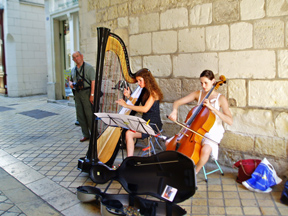 Street musicians Clémence Ralincourt and Aliénor Mancip, Amboise, France |
We ended the day in Amboise drinking the wines from Touraine (the region we were in) and eating our usual salads
— temperatures for most of our time in France were about 100¾ and
salads were the perfect meals. I found an internet café to send emails
to family and friends and enroute passed 2 women musicians, Clémence
Ralincourt (violin cello) and Aliénor Mancip (harp). The music was delightful and they were both
excellent musicians. Like in many countries, music students making some
money, practicing and popularizing themselves.
Chenonceau was our next chateau and it was here that we saw an
exhibition of Claudio Bravo in the grand gallery. Raymond was particularly
pleased to see this exhibit since he had only had second-hand knowledge
of Bravo’s work when, in 1997, Abbeville Press sent him the catalogue Claudio Bravo:
Paintings and Drawings by Paul Bowles and Mario
Vargas Llosa. Very much impressed
with Bravo’s particular skill within the realistic style, visiting this
exhibit gave him the first opportunity to see his paintings first hand
and not in reproduction. It is not uncommon for there to be an show in
a chateau. (We saw this in Switzerland as well, where an exhibition from
The Metropolitan Museum of Art was featured). In the afternoon we headed
to Blois and the Chateau, which has 4 distinct architectural
styles dating from the 13th century through the Gothic and Renaissance periods.
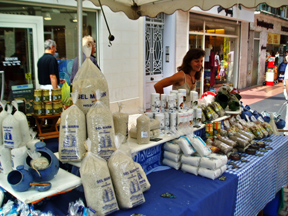 Christine, salt-harvester/seller at the market in Saumur, France |
The following day found us packing up and heading further West. We stopped at Villandry, also a privately owned historic chateau, and skipping the chateau went to the kitchen and herb gardens that were reconstructed from XVI century gardens. A Crafts Show was on in one of the farm buildings with 20 craftspeoples’ work on display with a person overseeing and selling. It seemed as if they were part of a guild. The work was excellent and included fabric, jewelry, wood sculpture, and pottery. Art shows, craft shows, take place in all different venues.
On to Saumur,
where we settled into the Loire Hotel in a room that faced the Saumur Chateau and overlooked the Loire River. Saumur is in the Anjou region that produces some of France’s finest fruits
(Anjou pears) and vegetables. What a great view to wake up to each morning,
and to hear the lapping of the water on the shore. The bridge crossing
the Loire was first documented in 1162, and was the only crossing point
of the Loire between Angers and Tours (approximately 70 miles) and made Saumur an important
center for trade. The river was a vital part of people’s lives up until
the railroad took over transporting people and goods. Today the river
is often too shallow for boats to pass. Jacky and I explored the town
and the men went to the Tank Museum and
to the National Riding School,
est. 1814 and known for the Cadre Noir horses which have a distinctive style of dressage. I was again fortunate
to be there during the Saturday Market and met Christine, a harvester of grey salt. Grey Salt is a “moist” unrefined sea salt usually found on the coastal areas of
France. Its light grey, almost light purple color, comes from the clay
found in the salt flats. The salt is collected by hand using traditional
Celtic methods. So of course this became my souvenir for friends and family,
and I went home with several kilos of salt! I also spoke with a woman
who was selling crafts made by teenagers that were part of some social
service program. This was a way for them to make some money and add to
their sense of self-worth.
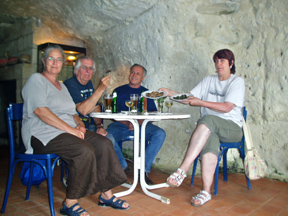 (L to R) Cornelia Seckel, Raymond Steiner, Jörg Iwan and Jacky Sparkowsky enjoying some of the mushrooms grown in the mushroom cave. |
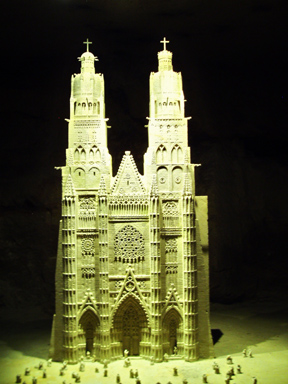 “Tours”: One of the limestone sculptures by Philippe Cormand at “Pierre et Lumìere” — Saumur, France |
We
said our goodbyes to the Loire Valley and headed to Switzerland trying to get away from the Tour de France crowds and barely succeeding.
We again passed fields and fields of sunflowers, wheat, and grapes before
reaching Geneva and beginning our trip around the southern shore of the
lake. The houses were gorgeous, sailboats and marinas in every city, small
beaches to fish, swim or take out a boat. We stopped at an excellent hotel
in Evian (I did get a bottle of water when we left), swam in the lake,
walked along the shore, and had an excellent meal, which included the
best crème brulée I ever had. I can still recall the taste.
Our time with Jacky and Jörg was coming to an end, for now. Traveling
with them is always a pleasure as they introduce us to worlds we didn’t
know existed and when they are here we try to do the same for them. They
drove us to Switzerland— no more stopping at borders and stamping
of passports and the views of the mountains were breathtaking. It was
hard to stop looking out the windows at one spectacular vista after another
and back again, and after a while our necks were sore and heads dizzy
from so many sudden movements. We drove through Sierre and then
up to Montana and then Crans before making the final trip
up to Aminona (nearly 1600 meters up) where we met with Heinz
& Christiane Jarczyk and Christiane’s sister Ursula and
husband Charles Esslinger and had a welcoming lunch. What a different atmosphere with snow-capped mountains in every
direction. The air of course was cooler and drier and after such heat
in the Loire Valley this was a welcomed relief. Tears, hugs and Jacky
and Jörg headed back to Berlin, a good 10-hour drive.
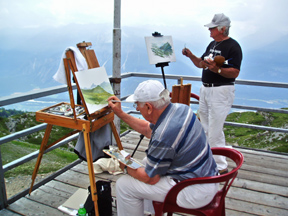 Heinrich J. Jarczyk (foreground) and Raymond J. Steiner painting at the Violettes: Valais, Switzerland |
Aminona, in the region of The Valais, as well as Crans-Montana (www.crans-montana.ch) the two nearby towns, offers hiking, golf (home of the Omega European Masters), mountain biking, tennis, watersports on the lakes, and of course skiing. It was in Aminona that the first downhill ski competitions took place in the 1920’s. There are concerts, theatre performances, nearby museum exhibitions (The Fondation Gianadda in Martigny had an exhibit, History of European Painting, covering a period of five centuries), galleries, and a weekly market with crafts to round out the extensive offerings of this idyllic place. Or, as our men did, one can sit and watch the mountains change from moment to moment and attempt to capture some of its essence on canvas. I had been thinking of hiking in the Alps for a long time and was so pleased to be able to walk with Ursula and Christiane, both born in Switzerland and as children hiked the mountains with their school classes every week. Ursula and Charles have an apartment in Residences Kandahar, 3 tall buildings with varying sized apartments, often available for rent. We chose a studio with a view rather than a 1 bedroom and no view —that didn’t really seem to be a tough decision. It was hard to stop looking out of our window that faced South directly into the Val d’Anniviers with its snow-capped mountain range. We were next door to Heinz & Christiane and that was just great as we shared our evening meals. Walking those mountains each day, eating alpine strawberries and raspberries, seeing flowers, waterfalls, and the piping system that brought milk down from the upper regions to the towns was relaxing and enlightening. It was wonderful to see the different flowers, some so similar to plants we have, others that I had never even seen the construction of.
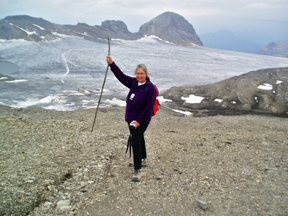 Cornelia Seckel at Le Plain Mort, the glacier 9000 feet above Crans-Montana, Switzerland |
The cows with their huge bells wandered
the meadows, and we stopped and bought cheese from one of the farms we
passed. Ursula knew these mountain paths well having skied and hiked there
for 30 years, and so it was again a delight to be led and have someone
else decide which paths to take. In my usual work and life I am the one
that makes the decisions and what a pleasure to leave it to Ursula! We
hiked between 3 & 5 hours each day (as Heinz and Raymond painted each
day, desperately trying to capture the illusive light as it played over
mountains and valleys) and at one point, having taken the funicular up,
we hiked down from le plain mort, a glacier that is at 9000 feet
and the temperature of 45¾. We tried to walk to the glacier, but the ground
was soft and the way too steep. Global warming has affected this glacier,
as it has everything else — several years ago people were cross-country
skiing on it in the summer! My favorite hike was up to La Tieche,
across an alpine field that was quite untouched by skis and machinery
and on to a waterfall. Our last night was spent in Ursula & Charles
apartment and we had Raclette, a meal of raclette cheese melted and poured
over potatoes and served with pickles. This traditional meal — along
with a bottles of Fendant wine (of Valais) — was a perfect way to
end our time in the Alps. It was with sadness that we left Aminona, our
friends, and mountains to head down to Sierre and on to Geneva.
The train ride around the northern part of Lake Geneva was easy and quite enjoyable. The transportation system in Europe is always efficient and quite manageable. We headed to our hotel (between downtown Geneva and the airport) and rested up before beginning our explorations of the city. We spent the most of two days in Geneva, and during that time we walked around the old city, saw many of the 187 banks, visited a museum, a synagogue, the League of Nations buildings, and met some very interesting people. Geneva is truly an international city. I couldn’t see a majority of any one people, just lots and lots of people of different colors, sizes, and shapes, wearing native clothing and speaking languages I couldn’t begin to guess. As with any big city there are, according to a booklet I got from the tourism office, 46 museums, 110 art galleries, 33 theaters and 100 bookstores. The museum we visited, Musées d’Art et d’Histoire, had an exhibition of Charles –Édouard Jeanneret (better known as Le Corbusier), the influential Swiss architect who, as a painter and sculptor, was the founder (along with Ozenfant) of Purism. Entitled “Le Corbusier ou la Synthèse des arts”, this comprehensive exhibition reveals just how much he had contributed to the modernist movement.
 Memorial Service for Dr. Alexandre Bezalel Safran at Synagogue Beth Yaacov, Geneva, Switzerland |
Probably
the most outstanding experience of our time in Geneva was a service we
attended at the Sephardic Synagogue Beth Yaacov. On Saturday afternoon
when we first arrived, we went to see the Synagogue noted in our tourist
information and fortunately we met a family, who after our acknowledging
that we were Jews, told me a bit about the Synagogue and Jewish life in
Geneva. We told him that we were sorry to have missed the Sabbath services
earlier that day. This building appeared Moorish to us, and we learned
that it was built in the 1700’s in the outskirts of the town as Jews were
not welcome in the center — now, of course, this area is encompassed
by the city. There are 15,000 Jews in Switzerland, 10,000 in Geneva according
to Mr. Kaplan, the gentleman who had shared information about the
Synagogue. He then invited us to attend the service the following morning
for the head Rabbi of Geneva who just died at the age of 94. On our first
trip to Europe some 15 years ago we had been to a service conducted in
German and Hebrew in Bern, Switzerland, and now we heard a service in
French and Hebrew. What a wonderful experience. First, that we were able
to see the exquisite interior of the synagogue with its Lion motif repeated
in abstract form along the interior, to see the beautiful stained glass,
and mostly to be part of the moving ceremony that acknowledged Dr.
Alexandre Safran, apparently from the gathering of dignitaries, an
important and greatly revered teacher for the Jewish community and the
city of Geneva. As well as the memorial liturgy there were nine speakers,
including the head Rabbi of France, Marc Raphaël Guedj, the founder
of the Roots and Sources Foundation in France, Mr. Abraham Y.
Schlesinger Chief Rabbi of The Orthodox Community Machsike Hadass,
and representatives from the city of Geneva, the University, and other
Jewish organizations in Geneva. Security around the synagogue was intense
and all bags were checked, identification looked at before we were allowed
to enter the synagogue. Attending this service was the perfect cap for
an altogether informative and pleasurable sojourn in Europe.
Traveling is a wonderful way to explore other people, other ways
of life, and to get a much better understanding of ones’ own life. We
were so fortunate to have this time, and to be able to share it with you,
my readers.
